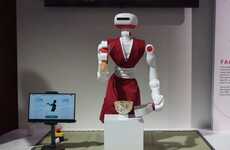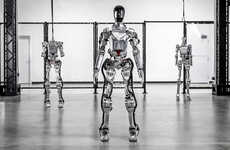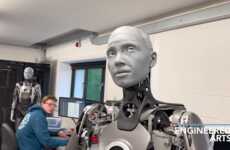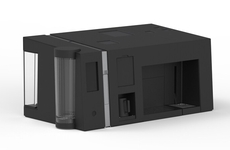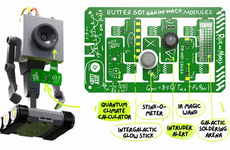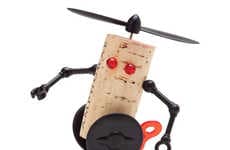
The Hasegawa Bot Learns, Thinks and Behaves Like a HumanBeing
Omar Yusuf — August 12, 2011 — Tech
References: diginfo & geekologie
The human brain is nothing more than a glorified computer program and, after combing over the mechanics of our neural networks, the Hasegawa Bot came into being. Capable of rudimentary problem solving, learning from its mistakes and pouring a cup of coffee, this android veers disturbingly close toward the Uncanny Valley.
Modeled after our own mysteriously efficient brains, the Hasegawa Bot was fitted with a Self-Organizing Incremental Neural Network (SOINN); ostensibly a brain that can modulate its shape based on tasks, goals and learned skills. The Tokyo University of Technology researchers who pieced together the mechanical man are confident in the thousands of practical applications for self-teaching automatons; they'll be able to avoid industrial accidents, fulfill roles more effectively and potentially improve production methods.
Traditionally, the sight of an intelligent, independent robot is enough to send shivers down one's spine. But don't fear, this robot's current job involves pouring coffee to the amusement of Japanese engineers.
Modeled after our own mysteriously efficient brains, the Hasegawa Bot was fitted with a Self-Organizing Incremental Neural Network (SOINN); ostensibly a brain that can modulate its shape based on tasks, goals and learned skills. The Tokyo University of Technology researchers who pieced together the mechanical man are confident in the thousands of practical applications for self-teaching automatons; they'll be able to avoid industrial accidents, fulfill roles more effectively and potentially improve production methods.
Traditionally, the sight of an intelligent, independent robot is enough to send shivers down one's spine. But don't fear, this robot's current job involves pouring coffee to the amusement of Japanese engineers.
Trend Themes
1. Self-teaching Automatons - The Hasegawa Bot's Self-Organizing Incremental Neural Network opens up opportunities for robots to learn tasks and skills independently.
2. Human-like Androids - The Hasegawa Bot's uncanny resemblance to humans paves the way for the development of androids that can perform complex tasks and interact with humans seamlessly.
3. Brain-inspired Robotics - The Hasegawa Bot's replication of the human brain's mechanics drives innovation in robotics by enabling robots to mimic human problem-solving and adaptability.
Industry Implications
1. Manufacturing - Self-teaching automatons could revolutionize manufacturing industries by improving production methods, avoiding accidents, and enhancing efficiency.
2. Service - Human-like androids have the potential to transform the service industry by performing complex tasks, such as customer service and caregiving, with a human touch.
3. AI and Robotics - Brain-inspired robotics opens up new possibilities in the field of AI and robotics, advancing the development of intelligent machines capable of learning and adapting autonomously.
1
Score
Popularity
Activity
Freshness

